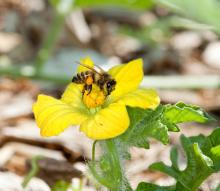Colony Collapse Disorder and Pollinator Health

Colony Collapse Disorder (CCD) is the sudden die-off of honey bee colonies. Pollination is vital to our survival and the existence of nearly all ecosystems on earth. One-third of our diet comes from insect-pollinated plants, and the honeybee is responsible for 80% of that pollination. CCD threatens not only pollination and honey production but, much more, this crisis threatens to wipe out the production of crops dependent on bees for pollination.
Pollinators contribute more than$24 billion to the U.S. economy, with $15 billion coming from honeybees alone. Considering this dependency, reduced honeybee and pollinator populations pose a serious risk to domestic agriculture, ecological health, and the U.S. economy.
There have been many theories about the cause of CCD, but the researchers who are leading the effort to find out why are now focused on various factors (Source: Environmental Protection Agency - Colony Collapse Disorder):
- Increased losses due to the invasive varroa mite (a pest of honey bees)
- New or emerging diseases such as Israeli Acute Paralysis virus and the gut parasite Nosema
- Pesticide poisoning through exposure to pesticides applied to crops or for in-hive insect or mite control
- Stress bees experience due to management practices such as transportation to multiple locations across the country for providing pollination services
- Changes to the habitat where bees forage
- Inadequate forage/poor nutrition
- Potential immune-suppressing stress on bees caused by one or a combination of factors identified above
See below for selected resources for CCD from agencies and organizations with an interest in the prevention, control, or eradication of invasive species.
Spotlights
Selected Resources
The section below contains highly relevant resources for this subject, organized by source.
